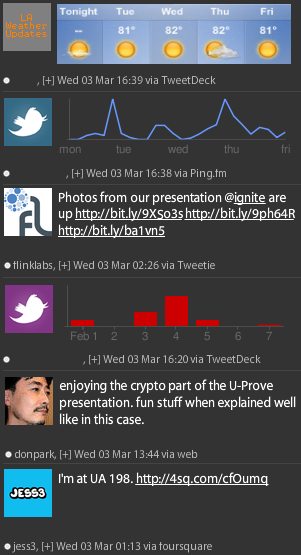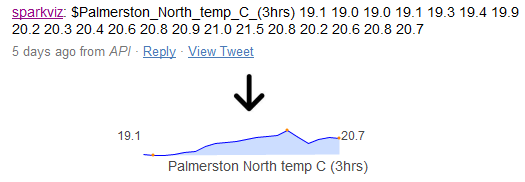Inline Images for Twitter Clients
By: Jeff Clark Date: Wed, 03 Mar 2010
Wouldn't it be cool if your twitter client could directly show tweets with small embedded images? Things like stock charts, graphical weather reports, server status, traffic reports, graphical emoticons expressing emotional state of your friends, mini-graphical movie ratings with thumbs up/down or stars, sports record summaries, or a million others that I haven't though of? Perhaps something like this?

This shouldn't be very hard. In fact, I think all that's required is the following:
- Somebody create a new URL shortener that by convention is only for links to images of dimensions 234x60 pixels or smaller. It should verify at the time of link creation that images fulfill the size constraint. I'll call it inpic for now but any short name would work.
- Twitter clients that want to support inline images in tweets are modified to recognize tweets with links to http://inpic.com/ABCD and display the image inline rather than the text link. Twitter clients that don't support inlining would show the text link and people could see the image with a click as they do now.
Step 1 is easy. There are hundreds of URL shorteners already in existence. We just need to adopt one that indicates by its' name that it points to a small embeddable image. An alternative that would avoid having to get different companies to adopt the same convention would be to use a special hashcode to indicate the same thing. Have all tweets with any link and the tag #inlinedimage handled by showing the image inline. If the link is invalid or doesn't point to a small image then the twitter client should revert to showing the text form.
Step 2 is easy as well since Twitter clients already show images in tweets - the user avatar images. I chose the size constraint by measuring the space used by TweetDeck to show the text of a tweet - I got about 237x62 pixels. This is just slightly bigger than the standard half banner size of 234x60 used for online advertising so I chose that instead.
Here are a few more things that could be added to make this even more useful:
- The URL shortener service (inpic or whatever it gets called) would host images in a manner similar to twitpic.com
- Twitter clients would support letting people easily embed graphical emoticons.
- If a second link in an inline image tweet is provided it would act as a browser target link if the inline image is clicked on. So an inline image in a tweet would give summary information and when clicked on the user would see more details inside a browser window.
- Twitter clients that support this might have an option to turn it off for anyone who prefers to always see text.
I think many people would find this valuable and it seems quite simple to accomplish. Come on TweetDeck, Twhirl, and other Twitter Client companies - get to work!
Where this idea came from
This morning I came across the interesting post Visualizing time series data embedded in tweets by Chris McDowall. The basic idea he discusses is to send time series data in tweets and have twitter clients recognize the format and present it as a small graph ( or Sparkline ) embedded in the tweet stream rather than just text. Chris seemes to have been inspired by the Twitter Data proposal.

It's an intriguing idea and Chris created a proof of concept twitter client called the Twitter Sparkline Visualizer.
One problem I see is that a twitter client that doesn't recognize the special data format would show the cryptic form which would probably be undesirable in most cases. Also, the 140 character limit of a tweet would put a fairly tight boundary on how much could be encoded. In a comment on the post, Tom Carden suggested looking at the Google Charts API as a "good example of a concise vocabulary for passing chart data around using URLs".
Tom's suggestion triggered an idea for me: Use any RESTful api like Google Charts to encode small charts in a URL, then use a URL shortener to construct a tweetable link representing the chart. Furthermore, we can use a specially named URL shortener that indicates to a twitter client that all of its' links point to small inline charts. This lets a twitter client determine efficiently that a given link can be rendered inline.
It makes sense to generalize the idea further to support use of any small image rather than charts in particular.